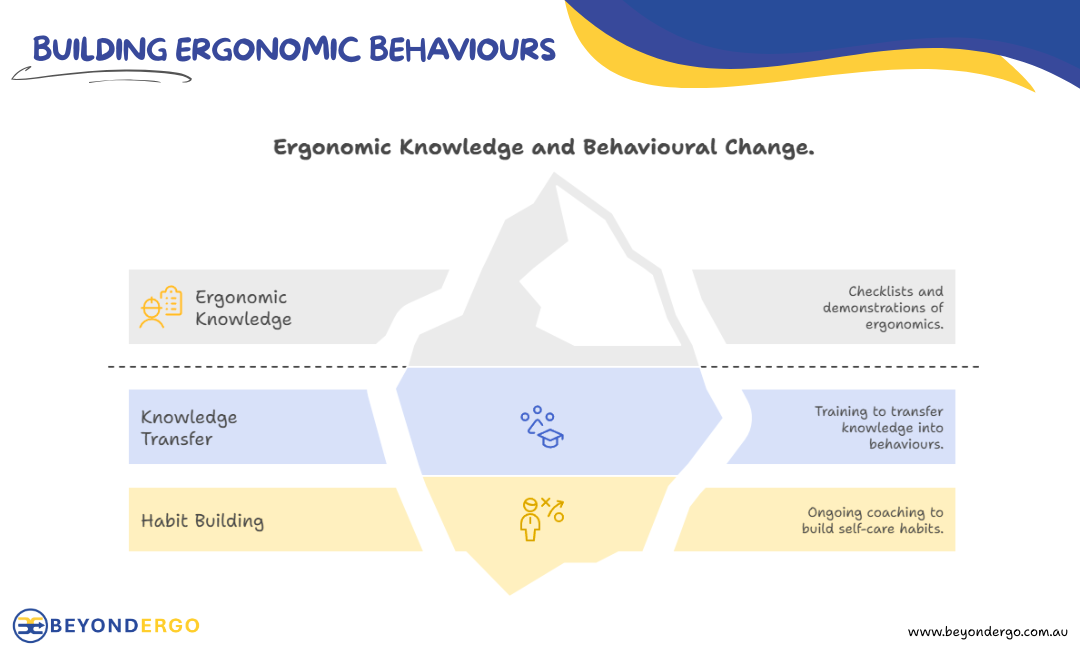Have you wondered about Ergonomic Behaviours?
Have you ever noticed how some workplace training feels… familiar?
The slides, the checklists, the reminders about good posture and desk setup.
Most ergonomic programs haven’t changed in a decade. They teach what to do — but not how to make it stick.
Here’s the challenge: research shows only about 10% of ergonomic training is ever applied. That means 90% of that effort — time, cost, good intentions — quietly melts away.
And it’s not because people don’t care.
It’s because knowledge without action isn’t behaviour change.
THE REAL PROBLEM
Think about the last time you sat through ergonomics training. You probably learned about monitor height, keyboard position, and maybe the importance of taking breaks. You nodded along. It all made sense. And then you went back to your desk and… did exactly what you were doing before.
This is the “knowing-doing gap.”
And in ergonomics, that gap is costing organisations in ways they don’t even measure—preventable injuries, chronic discomfort, lost productivity.
The question isn’t “Do people know what good ergonomics looks like?” The question is: “Why aren’t they doing it?”
THE ICEBERG PRINCIPLE
At Beyond Ergo, we think of ergonomic success like an iceberg.
- Above the surface is knowledge. The facts. The “what” and the “why.”
- Below the surface lie the deeper forces that actually change ergonomic behaviour — actions, habits, coaching, and culture.
Most training programs focus entirely on what’s above the surface. They assume that if people just knew better, they’d do better.
But research in behavioural science tells us something different: Knowledge is necessary, but it’s rarely sufficient.
THE THREE LAYERS BUILD ERGONOMIC BEHAVIOURS
So what does it actually take to change ergonomic behaviour? Let me break down the three layers:
Layer One: Build Awareness
Yes, people need to understand what the recommendations for good ergonomics are and why they matter. But the real gold? When employees can identify discomfort early and understand its cause, they’re more likely to take ownership and action to care for themselves.
Layer Two: Transfer Knowledge into Action
This is where most programs fail. It’s not enough to tell someone “adjust your chair” or even “How to adjust your chair.” They need coaching, practice, and confidence to personalise the recommendations to match their body and then make those adjustments without waiting for an expert to show up.
Think about it: Would you expect someone to learn piano from a single demonstration? Of course not. Skill requires repetition and feedback.
Layer Three: Build Lasting Habits
Real change doesn’t come from a workshop. It comes from consistent reinforcement over time.
Research shows that habit formation requires environmental design, social support, and regular coaching. That’s how awareness becomes automatic behaviour, and that is why supporting leaders’ coaching skills is a strong element in the Beyond Ergo programs.
WHY THIS MATTERS NOW
Here’s why this is more urgent than ever:
Work has fundamentally changed. We’re hybrid. We’re remote. We’re switching between home offices, coffee shops, and hot desks.
Traditional ergonomics was designed for static office environments. But the future of work demands something different—it demands self-sufficiency.
Employees need to become their own empowered ergonomics experts. And that requires skills, not just information.
When people feel comfortable and capable in their workspace, the benefits compound:
- They’re healthier
- They’re more productive
- They’re more creative
- They’re more reliable
This isn’t just about reducing workers’ comp claims—though that matters. It’s about building a culture where people can do their best work.
A workforce that’s more resilient, capable, and ready to thrive —
and a workplace where wellbeing isn’t a slogan, it’s a practice.
RETHINKING THE TRAINING APPROACH
So what would an evidence-based approach to ergonomics actually look like?
It would combine a few key elements:
- Experiential learning – People learn by doing, not just listening.
- Behavioural science – We design for how humans actually form habits, not how we wish they did.
- Modern context – Training adapts to hybrid and remote work, not just traditional offices.
- Ongoing coaching – Managers are equipped to reinforce healthy practices, not just HR doing annual check-ins.
The shift is from compliance training to capability building.
From “We told them what to do” to “We helped them build the skills to do it.”
THE BIGGER IDEA
Here’s what I think this really comes down to:
Organisations say they care about employee well-being. But caring isn’t enough.
You can care deeply about your people and still design systems that fail them—not because of bad intentions, but because of outdated assumptions.
The assumption that knowledge equals behaviour change is one of those outdated ideas.
If we’re serious about workplace wellbeing, we need to close the knowing-doing gap.
Because the goal isn’t just to teach people what ergonomics is. It’s to help them live it.
DISCOVER MORE
At Beyond Ergo, we have translated ergonomic and healthy work recommendations into actionable skills, enabling you to build a high-performing team and foster unstoppable team loyalty.
If you’re a leader ready to transform your training and build real workplace wellbeing — we’d love to connect.
👉 Book a Discovery Call
Or 💡 Register for the Beyond Ergo Newsletter for more insights on wellbeing that works.

